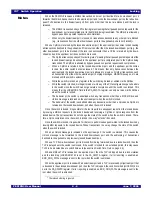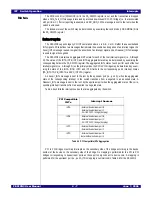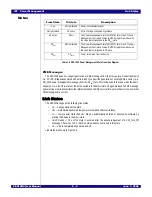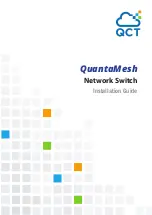
IDT Hot-Plug and Hot-Swap
Introduction
PES12N3 User Manual
6 - 5
June 7, 2006
Notes
The I/O expander has an open drain interrupt output that is asserted when a pin configured as an input
changes state from the value previously read. The interrupt output from the SMBus I/O expander should be
connected to GPIO[2], and GPIO[2] should be initialized during configuration to operate in alternate function
mode as the Hot-plug I/O expander interrupt input. See Chapter 8, General Purpose I/O.
Whenever a input to the I/O expander changes state from the value previously read, the interrupt output
of the I/O expander connected to GPIO[2] is asserted. This causes the PES12N3 to issue a master SMBus
transaction to read the updated state of the I/O expander inputs.
Regardless of the state of the interrupt output of the I/O expander, the PES12N3 will not issue a master
SMBus transaction to read the updated state of the I/O expander inputs more frequently than once every 40
milliseconds. This delay in sampling may be used to eliminate external debouncing circuitry. The 40 milli-
second sampling frequency also applies to the Hot Plug Port A Attention Button (PAABN) GPIO alternate
function.
Port B input values are read from I/O expander register 0 and Port C values are read from I/O expander
register 1. The I/O expander interrupt request output is negated whenever the input values are read or
when the input pin changes state back to the value previously read. Any errors detected during I/O
expander SMBus read or write transactions is reflected in the status bits of the SMBus Status
(PA_SMBUSSTS) register. The I/O Expander Interface (PA_IOEXPINTF) register allows direct testing and
debugging of the I/O expander functionality.
The Port B Hot-Plug Signals (PBHPS) and the Port C Hot-Plug Signals (PCHPS) fields in the
PA_IOEXPINTF register reflect the current state, as viewed by the PES12N3, of all of the I/O expander
inputs and outputs.
Writing a one to the Reload I/O Expander Signals (RELOADIOEX) bit in the PA_IOEXPINTF register
causes the PES12N3 to generate SMBus write and read transactions to the I/O expander, causing the
value in the PBHPS and PCHPS fields to reflect the state of the I/O expander signals. This feature may be
used to aid in debugging hot-plug operation. For example, a user who neglects to configure GPIO[2] as an
alternate function may use this feature to determine that master SMBus transactions to the I/O expander
function properly and that the issue is with the interrupt logic.
The I/O Expander Test Mode (IOEXTM) bit in the PA_IOEXPTINF register allows an I/O expander test
mode to be entered. Normally, hot-plug outputs which are generated by ports B and C first update the
PBHPS and PCHPS fields before being written to the I/O expander. When this bit is set, these hot-plug
outputs are blocked from updating the fields. Instead, values written directly to the PBHPS and PCHPS
fields will be sent to the I/O expander. In this mode, the PES12N3 issues a transaction to update the state of
the I/O expander whenever a bit corresponding to a hot-plug controller output in these fields changes state
due to a configuration write.
Hot-Plug Messages
The PCI Express Base Specification revision 1.0a allows the attention indicator, power indicator and
attention button to be implemented on an add-in card instead of the board on which the slot is located. To
support this, the specification defines messages that implement virtual wires between the add-in card and
the hot-plug controller associated with the slot. The PCI Express Base Specification revision 1.1 removed
this capability.
When the Hot Plug Mode (HPMODE) bit is set in the Switch Control (PS_SWCTL) register, the hot-plug
controllers operate in PCIe revision 1.1 mode and no downstream messages are generated by the port B or
C hot-plug controllers. In addition, if a hot-plug message is received on these ports in this mode, it is silently
discarded.
If the HPMODE bit is cleared (default value), then hot-plug messages are generated and processed
when received by the port B and C hot-plug controllers.
A downstream ATTENTION_INDICATOR_ON, ATTENTION_INDICATOR_BLINK, or
ATTENTION_INDICATOR_OFF message is sent down on port B or C when the hot-plug controller associ-
ated with the port is enabled and the state of the Attention Indicator Control (AIC) field is modified in the
PB_PCIESCTL or PC_PCIESCTL register.
Summary of Contents for 89HPES12N3
Page 10: ...IDT Table of Contents PES12N3 User Manual iv June 7 2006 Notes...
Page 14: ...IDT List of Figures PES12N3 User Manual viii June 7 2006 Notes...
Page 36: ...IDT Clocking Reset and Initialization Reset PES12N3 User Manual 2 8 June 7 2006 Notes...
Page 40: ...IDT Link Operation Slot Power Limit Support PES12N3 User Manual 3 4 June 7 2006 Notes...
Page 50: ...IDT Switch Operation Switch Core Errors PES12N3 User Manual 4 10 June 7 2006 Notes...
Page 54: ...IDT Power Management Active State Power Management PES12N3 User Manual 5 4 June 7 2006 Notes...
Page 62: ...IDT Hot Plug and Hot Swap Hot Swap PES12N3 User Manual 6 8 June 7 2006 Notes...
Page 78: ...IDT SMBus Interfaces Slave SMBus Interface PES12N3 User Manual 7 16 June 7 2006 Notes...
Page 148: ...IDT Test and Debug SerDes Test Clock PES12N3 User Manual 10 6 June 7 2006...
Page 158: ...IDT JTAG Boundary Scan Usage Considerations PES12N3 User Manual 11 10 June 7 2006 Notes...
















































